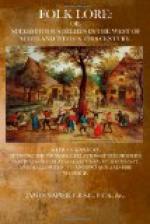The origin of this custom of running the braize—it was so pronounced in the west county—has long been a puzzle to antiquarians. Probably it is the survival of a custom practised by our Scandinavian forefathers. A Scandinavian hero or warrior considered it beneath his dignity to court a lady’s favour by submitting the matter of marriage to her decision. When he saw or heard of a beauty whom he decided to make his wife, he either went direct and took her away by force from her home, or he gained the right to make her his bride by success in battle with his opponents. Often, however, one who was no hero might gain the consent of the parents to his marriage with their daughter, she having little or no voice in the matter; and when she and her friends were on their way to the church, some heroic but unapproved admirer, determined to win her by force of arms, having collected his followers and friends who were ever ready for a fight, would fall upon the marriage cortege, and carry off the bride. Under those circumstances there was often great anxiety on the part of both the groom’s and bride’s relations, who remained at home when they had reason to apprehend that such attack might be made, and so, whenever the marriage ceremony was over, some of the company hasted home with the glad news; but commonly youths stationed themselves at the church-door, ready to run the moment the ceremony was over, and whether on foot or horseback, the race became an exciting one. He who first brought the good news received as a reward a bowl of brose, and such brose as was made in those days for this occasion was an acceptable prize. Although the necessity for running ceased, the sport occasioned by these contentions was too good and exciting to be readily given up, but it came to be confined to those who were at the wedding, and many young men looked forward eagerly to taking part in the sport. The prize which originally was brose, came to be changed to something more congenial to the tastes and usages of the times, viz., a bottle of whiskey. In this way, I think, we may account for the custom of “running the braize.” It has been mentioned already that the best man went with the bride to the minister. His duty it was to take charge of the bride and hand her over to the bridegroom, a duty now performed by the bride’s father, and in this now obsolete custom, I think we may find a still further proof that the management and customs of the marriage procession were founded upon the old practice of wife-capture. The best man is evidently just the bridegroom’s friend, who, in the absence of the bridegroom, undertakes to protect the bride against a raid until she reaches the church, when he hands her over to his friend the bridegroom.




